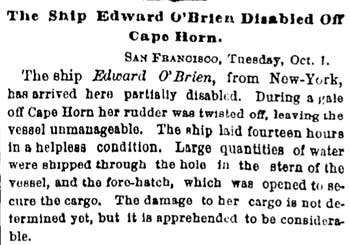Patagonia Bookshelf
Calamities, sufferings and atrocities: as told by survivors and observers
INTRODUCTION
 The Ship Edward O'Brien Disabled off Cape Horn. /
San Francisco, Tuesday, Oct. 1. / The ship Edward O'Brien, from New-York, has
arrived here partially disabled. During a gale off Cape Horn her rudder was
twisted off, leaving the vessel unmanageable. The ship had fourteen hours in
a helpless condition. Large quantities of water were shipped through the hole
in the stern of the vessel, and the fore-hatch, which was opened to secure the
cargo. The damage to her cargo is not determined yet, but it is apprehended
to be considerable.
The ship Edward O'Brien disabled off Cape Horn
The Ship Edward O'Brien Disabled off Cape Horn. /
San Francisco, Tuesday, Oct. 1. / The ship Edward O'Brien, from New-York, has
arrived here partially disabled. During a gale off Cape Horn her rudder was
twisted off, leaving the vessel unmanageable. The ship had fourteen hours in
a helpless condition. Large quantities of water were shipped through the hole
in the stern of the vessel, and the fore-hatch, which was opened to secure the
cargo. The damage to her cargo is not determined yet, but it is apprehended
to be considerable.
The ship Edward O'Brien disabled off Cape HornNew York Times, 2 October 1867
Ever since the first Europeans ventured into the seas around Cape Horn, their perils have been legendary: hurricane-force winds, mountainous waves and uncharted rocks. Under such conditions, the slightest human error or equipment failure can lead to disaster. Calm weather was equally hazardous to sailing ships, since they drifted helplessly, sometimes breaking up on the rocky coast.
Nonethless, by the late 19th-century, these waters carried a constant traffic of ships, transporting passengers and freight. It was an age of transition: coal was slowly replacing wind as the source of power. Since steam-driven vessels were comparatively independent of the prevailing wind strength and direction, they were able to navigate the complex, but safer, waters of the Magellan Strait. Sailing ships preferred to take the more hazardous southern route: they were thereby more vulnerable to accidents, and the consequences more catastrophic. The case of the Golden Hind is noteworthy, since it led to repercussions in diplomatic circles: the US representative suggested to the Chilean government creating a service of steam-tugs to tow sailing ships safely through the Strait.
Golden Hind: (1872) After prolonged gales, the ship lost its rudder and ran aground on the west coast of Tierra del Fuego.The crew abandoned ship in three boats, two of which were soon lost. The survivors, without any instruments, attempted to head for the Magellan Strait and the safety of Punta Arenas. One encounter with a native canoe yielded little food. Debilitated by cold and hunger, progress became slower, until the group was unable to advance further. Deaths occurred. In their hunger and desperation, the survivors had no other choice than to feed on the flesh of their companions. They were eventually rescued by a passing sealer.
San Rafael: (1876) After its cargo of coal caught fire, the frigate was abandoned. Much later, one boat was rescued by a passing ship; the other, with 9 people aboard, was wrecked on the south coast of Hoste Island. Unable to make their escape, the people suffered a slow death by hunger. The group was discovered by a group of canoe people, who took word to the mission station at Ushuaia. When the missionary Bridges and Captain Willis reached the site, there was little to be done beyond recording the names of the dead and their few possessions, and covering the remains. The natives were subsequently rewarded by the British government for their humanitarian assistance to sailors in distress.
Roseneath: (1882) This sailing barque attempted to round Cape Horn eastbound, heading for Britain. Four days of stormy weather caused an unstoppable leak, forcing all aboard to abandon her on the open ocean, and take to the boats. The captain, his wife and child, and five other survivors in the first boat were picked up a week later. The mate and four other sailors were in a second boat: they quickly made landfall, only to encounter an even mightier peril — fellow human beings. All but one were killed by natives in canoes. There followed a long period of captivity. Eventually, the survivor made his escape with another group of natives, ultimately being picked up in the Magellan Strait by a passing steamer.
These three first-hand reports are a small sample of the disasters that occurred with dreadful frequency. /§/ Such incidents, both pathetic and horrific, were widely reported in the English-language press: undoubtedly, they must have served to reinforce existings fears and stereotypes. /*/
The proclivity of some Cape Horn natives to kill shipwrecked sailors was already legendary; for good measure, they were suspected of being cannibals [see newspaper headline]. Modern commentators, for whom these events are a distant piece of history, may explain their aggression as territorial behaviour, or as a reaction to mistreatment by earlier "white" intruders. However, as the case of the Golden Hind reminds us, even the taboo of cannibalism is not absolute when survival is at stake.
/§/ See a sample of newspaper headlines. Also on this site, the story of the Manchester, wrecked in 1854.
/*/ At this period, it was commonplace to read reports of "outrages and atrocities", perpetrated by so-called "savages" all around the world. Examples placed before the public eye included the following locations: New Zealand (Poverty Bay, 1869), United States (Texas, 1870) and Australia (Northern Territory, 1874).